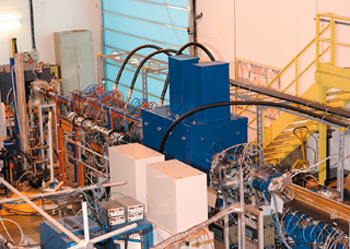
CERN’s new nuclear physics facility, REX-ISOLDE, was commissioned at the end of October, opening up new horizons for the laboratory’s nuclear physics community. REX-ISOLDE builds on CERN’s existing radioactive beam facility, taking radioactive ions and boosting them to energies of up to 2.2 MeV per nucleon.
ISOLDE, the isotope separator on line, has a history stretching back over 30 years supporting experiments from basic nuclear physics to the life sciences. To date, these have focused on radioactive nuclei at energies of less than 60 keV – an upper limit that was starting to constrain the facility’s potential. REX, the newly commissioned radioactive beam experiment, remedies this by opening up the 0.8-2.2 MeV range for exploration.
REX-ISOLDE has been built round a new linear accelerator, which was funded and constructed by a broad European collaboration. ISOLDE’s 60 keV ions are accumulated in a Penning trap, charge bred in an Electron Beam Ion Source and then finally accelerated in the linac. The first beams to be accelerated consisted of neutron rich sodium isotopes, which reached 2 MeV per nucleon on 30 October.
Researchers at the facility’s main detector system – a gamma detector array known as Miniball – are now starting early experiments probing whether the magic numbers N = 20 and N = 28 of the nuclear shell model are still valid for very neutron-rich nuclei. Future experiments will address topics that include the structure of nuclei with equal numbers of protons and neutrons, proton radioactivity and nuclear astrophysics.








